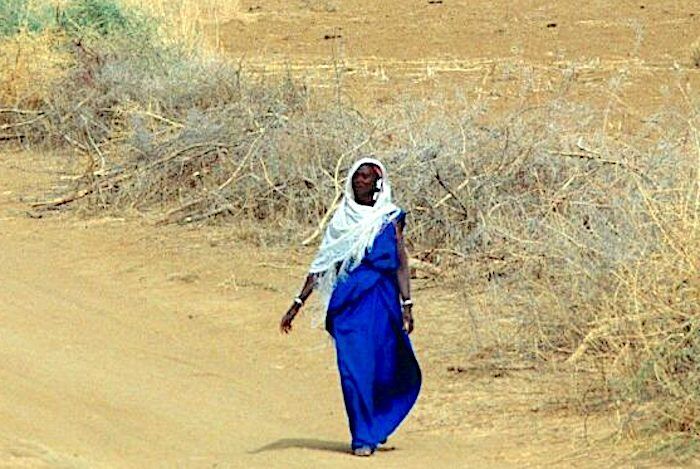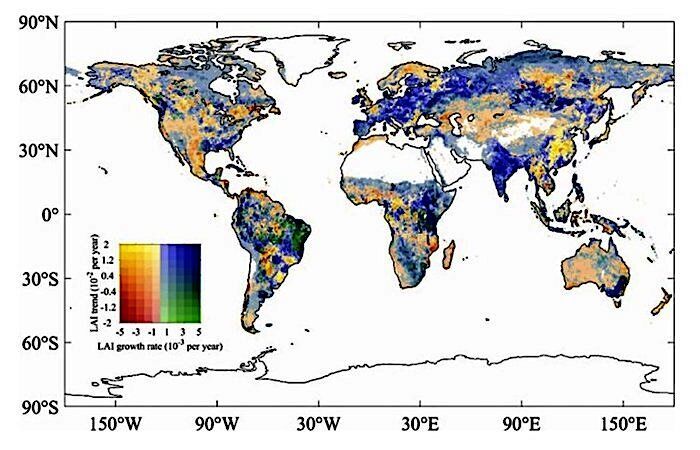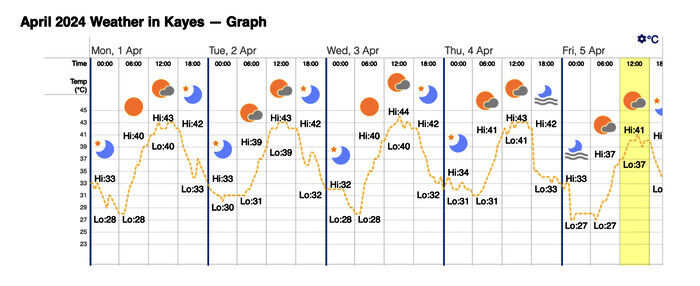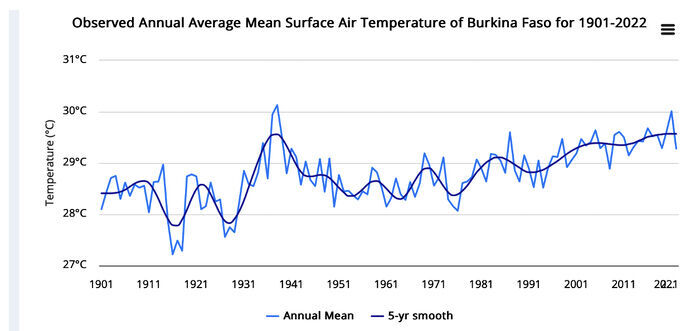This last fact is never likely to be mentioned in these footling stories dreamed up to promote Net Zero collectivisation. To do so would be to open a Pandora's Box showing global plant levels have accelerated due to the recovering levels of carbon dioxide in a previously denuded atmosphere. A recent science paper revealed that over the last two decades, plant growth had accelerated over large areas of the planet. During the last 40 years, it is thought that there has been 14% more plant growth, bringing immeasurable benefits for local biodiversity as well as more food for human consumption
The above illustration shows the boost to the natural world over just the last 20 years. Big increases in leaf growth are reported across India, Europe, Brazil and significant parts of Africa. The growth across the Sahel region south of the Sahara desert can be clearly seen.
None of this seems to attract the interest of activists writing in the mainstream media, seemingly concerned only to fear monger and push populations to embrace the insanity of Net Zero. The Guardian wrote of a protracted heatwave in the Sahel that "filled hospitals and mortuaries". Matt McGrath of the BBC reported a claim that additional heat "would have been the difference between life and death for many people". Both media operations were reporting the findings of World Weather Attribution (WWA), an operation partly funded by green billionaire Jeremy Grantham, that the "deadly heatwave" would have been "impossible" without humans ratcheting up the climate thermostat.
Regular readers of the Daily Sceptic will be aware of the model-driven crystal ball gazing of WWA. The service produces pseudoscientific opinions, but fails the test of the scientific process since its claims cannot be falsified. Further details are available here. Despite this lack of scientific rigour, the service provides useful 'scientists say' cover for legacy media in their Net Zero work.
Both the BBC and the Guardian picked up on the claim by WWA that the temperature rose above 48oC in the Mali city of Kayes on April 3rd, with the Guardian claiming the 48.5oC was the hottest day ever recorded in the country. Some doubt on this figure is cast by the data below provided by Time and Date.
According to this data, April 3rd saw a 44oC high, which was over four degrees lower than the claimed record, and this dropped away two days later to 41oC. As we have seen across the world, the collection of surface temperature data is subject to numerous corruptions. In the U.K., the Met Office compiles nearly 80% of its data from stations that have 'uncertainties' set by the World Meteorological Office of between 2-5oC. WWA states:
"Extreme five day maximum heat as rare as the observed event over Mali/Burkina Faso would have been between 1.5oC cooler and 1.4oC cooler over the larger Sahel region if humans had not warmed the planet by burning fossil fuels."Quite where such precision comes from is anyone's guess, including, it might be suggested, the computer wizards claiming their garbage-in-gospel-out models can unlock the mysteries of a chaotic atmosphere.
Away from the elites catastrophising about the weather for domestic political purposes, the countries of the Sahel including Burkina Faso and Mali have actually enjoyed a remarkably stable climate over the last 85 years.
Both Burkina Faso and Mali show similar average temperature trends and in common with many countries near the equator recent warming has been much less than territories further north. In fact, a large spike during the 1930s, presumably unrelated to humans burning hydrocarbons, was followed by an 85-year pause with little or no warming. The five year 2022 smoothed average temperature of 29.57oC in Burkina Faso, shown above in a World Bank climate graph, is almost exactly the same as that recorded in 1938. In Mali, the temperature difference between these two years is just 0.2oC.
Of course rainfall is very important, and in both countries precipitation amounts have risen in recent years. In Burkina Faso, annual amounts rose from 798.04 mm in the period 1961-1990 to 831.07 mm in 1991-2020, while in Mali the rise over the same period was 313.7 mm to 328.93 mm. Meanwhile, in the course of the BBC story, it is claimed that Senegal is seeing "decreasing rainfall as a result of climate change". Not according to World Bank figures which show an annual rise in precipitation from 707.87 mm in 1961-1990 to 722.91 mm in the latest 30-year period.
Overall then, the great story missing from the headlines is that the Sahel is slowly turning green. A few thousand years ago the Sahara desert was full of vegetation. Natural process and climate change turned it into a desert, a process that can easily go into reverse. The desert has shown a greener image over the last 15 years notes Britannica with heavier summer rainfalls reported. "This is a blessing for the desert as the vegetation recovers," it notes. Sub-Saharan Africa is a difficult place to make a living on the land. The area needs aid in the form of inorganic fertilisers to improve the soil and hydrocarbon power to boost productivity. But more rain from the heavens and higher levels of CO2 all have a part to play. What it really doesn't need is the BBC and the Guardian spreading nonsense stories inspired by green billionaires about the mortuaries filling up because hot countries have a few hot days.







Reader Comments